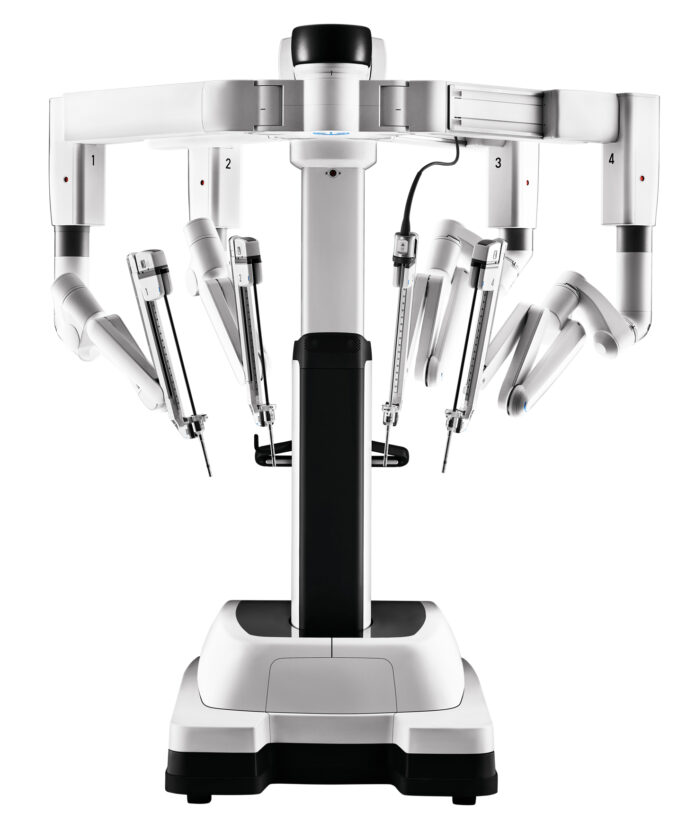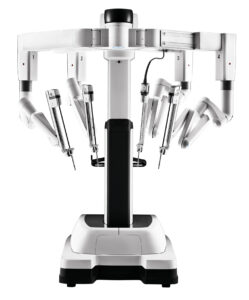New surgical robot arrives at Trinity
Device reduces scarring, infection risk
- The da Vinci Xi Surgical System was recently installed in UnityPoint Health — Trinity Regional Medical Center’s operating rooms.

The da Vinci Xi Surgical System was recently installed in UnityPoint Health — Trinity Regional Medical Center’s operating rooms.
UnityPoint Health — Trinity Regional Medical Center is the first hospital in the region to acquire a da Vinci surgical robot. The da Vinci Xi Surgical System was recently installed in Trinity’s operating rooms.
The surgical robot was purchased for $2,013,568.50 by Trinity Foundation after the State Health Facilities Council unanimously voted to approve the required Certificate of Need on May 15.
The da Vinci robot is a state-of-the-art surgical system that helps surgeons perform delicate procedures with greater precision, flexibility and control. This latest generation offers enhanced movement and visibility, allowing for minimally invasive surgeries that can lead to smaller incisions, less pain and faster recovery times. Trinity Regional Medical Center will primarily use the robot in gynecologic and general surgeries.
UnityPoint Clinic Surgery — Fort Dodge general surgeons, Dr. Ericha Worple and Dr. Laura Miegge and UnityPoint Clinic OB/GYN — Fort Dodge gynecologists, Dr. David Ilceski and Dr. Abby Sexton are all trained and using the robot for procedures. Dr. Darren Croo, general surgeon at UnityPoint Clinic Surgery — Fort Dodge, will begin using the robot after completing training in August.
“I’m incredibly proud of our team for securing state approval to bring this advanced technology to Trinity Regional Medical Center,” said Leah Glasgo, president of UnityPoint Health — Fort Dodge. “Introducing the da Vinci system is all about giving our patients access to the best possible care close to home. It’s part of our ongoing commitment to their comfort, safety and healing.”
The da Vinci provides surgeons with a highly magnified view, virtually extending their eyes and hands inside the patient.
“The robot allows us to combine the skills surgeons use in open and laparoscopic surgery with this new approach, leading to better outcomes and faster recovery,” said Worple. “The robot’s ability to mimic the movements of my hands allows us to perform very detailed, delicate work. It’s great for our patients and also helps attract new surgeons who are trained on the da Vinci in residency.”
The da Vinci Xi surgical robot allows the surgeon to operate through small incisions — about the size of a dime. Then they use a special console with hand and foot controls to move the robotic arms, which hold the instruments to operate. A small, 3D-HD camera helps surgeons see and perform intricate surgical procedures. The robot translates the surgeons’ natural hand motions at the control console into corresponding movements of the robotic instruments.
For most patients, the da Vinci offers many benefits:
∫ Shorter hospital stay
∫ Less pain
∫ Less risk of infection
∫ Less blood loss and transfusions
∫ Smaller incisions for minimal scarring
∫ Faster recovery
∫ Quicker return to normal activities
∫ Fewer complications
∫ Better clinical outcomes
The robot cannot be programmed or make decisions on its own — the surgeon is 100 percent in control of the da Vinci at all times.




